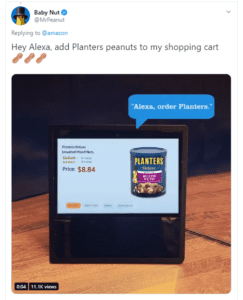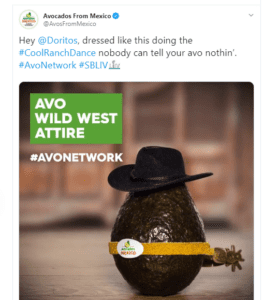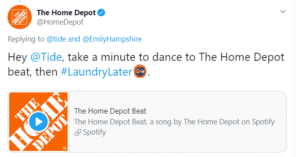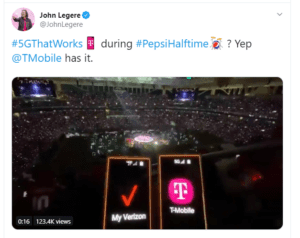You have probably read a lot of Super Bowl ad reviews today. Or have talked with your colleagues about your favorite commercials from last night. Or maybe you spent your lunch hour searching through the Half Time show memes. And you’ve most certainly done a Google search for “J.LO anti-aging regime.”
Given the flood of content about Super Bowl commercials, the game itself, and the halftime show, I have kept this piece focused on my personal experience during the big game. I haven’t read any Super Bowl commercial reviews or recaps (… yet), so I may not cover all the popular ads, but these are the big themes and ideas that stood out to me while live-tweeting during the event. Enjoy!
Live-tweeting and ambient sociability
I love social media interactions. I love the ambient intimacy – a feeling of closeness toward others developed mainly by sharing the same space with them (McGonial 2011) – of social media which adds to live media experiences. I really love this sociability layer added to the Super Bowl experience via a Twitter community that you haven’t or have barely known before. I find the majority of joy and satisfaction about the #SuperBowlAd watching centers around the live Twitter activity where I can see the first reactions of audiences and assess the brands’ real-time reactions to these real-time consumer tweets. This year, I had the joy of contributing to the #KelloggBowl hashtag lead by Professor Tim Calkins and his students at the Northwestern Kellogg School of Business Super Bowl Ad review team. I thank all these students for sharing their insights and my academic colleague Spencer M. Ross for bouncing ideas back and forth with me. This annual marketplace ritual comes full-circle when you expand and enrich your social media kin.
Meshed realities
One of the most important news items of Game Day was Verizon announcing that it would provide a 5G experience in Miami’s Hard Rock Stadium and that Super Bowl LIV would be the first 5G Super Bowl in history: ‘Through Verizon, there will be an overlay of data onto live plays, real-time VR and AR to give fans a player’s eye view, live in-stadium AR wayfinding and directions, live on-field graphics through AR filters, live-streaming via multiple camera angles, and more.” This was seminal as the field has been discussing 5G and its possible manifestations across categories. We have been predicting that broadcasting and sports entertainment, in particular, will be the frontier that will lead change in 5G. And, here it is. Exciting times ahead!
5G is the innovation we have been getting ready for for the last 20+ years. 5G will unlock and unleash the true potential of the existing innovations at their embryonic stages (eg, VR, AR, autonomous cars, IoT) and create a new ecosystem of reality – what we at Mintel call “meshed realities.” 5G-enabled consumer experiences will be a layered-mesh of augmented, virtual, and physical story worlds made up of human and non-human agents. In this new ecosystem, all the contextual information that we want or need will be layered onto our physical reality.
Streaming wars
The streaming wars persisted through the Super Bowl. Amazon Prime, Disney+, and Hulu ran commercials last night. There were even smaller, newer players like Quibi. It is exciting to hear some new and independent “junior” voices in the streaming wars. I, personally, like the “I’ll be there in a Quibi!” tag line. I will not go into the details of the content of each commercial, but the approaches taken by the big players were very similar: “Let’s flex our content muscle.” They mostly highlighted the content excellence approach where they have shown teasers to build excitement around their tent-pole content. Amazon Prime with Al Pacino in Nazi Hunters and Disney+ with the first look at the upcoming Marvel shows with Loki, Falcon, Winter Soldier, James Bond, and Black Widow. Recently, producing premium content has become the name of the competitive game in the streaming category. But, winning with content is getting more expensive – and will get more difficult – against big players with multi-billion dollar production and marketing budgets. Thus, going forward, content excellence cannot be the only competitive strategy for streaming wars. (See my blog for a more detailed discussion on the competitive strategies beyond content excellence in streaming wars.)
Hulu’s commercial was probably one of the most viral commercials in the streaming category. Tom Brady and some “ambiguity” built into the pre-game part of the commercial helped facilitate excitement and fostered the social media buzz. But I am concerned that these tactical executions will fall short in such a heated and dynamic competitive landscape. These viral marketing tactics will not build a brand and will hardly ever contribute to the strategic storytelling to position or differentiate the brand. I wish Hulu would have edited this content out of respect for the memory of Kobe Bryant. Personally, I didn’t like the “teased” hook of another athlete’s farewell.
Dancing with the enemy
We have seen several brands interacting with each other on social media during the Super Bowl. I like when brands playfully joust on social media and explore the synergistic effects of rivalry. It is a fun and light-hearted competitive approach that helps brands ride on each other’s social media buzz. Home Depot winked at Tide; Planters reminded Alexa/Amazon to order the peanuts; Snickers teased with Tide; and Avocados from Mexico poked fun at Doritos. Although these types of playful rivalries are entertaining for the audience, they don’t have much lasting strategic impact because the rivalry is mostly played among the brands in different categories. The social media managers pick an interesting or attention-grabbing commercial and want to ride on its tails of this brand to increase the social media visibility and buzz of their own brand. Some call this tactic as “brand equity” sharing, but I prefer the term “brand jousting” because “equity sharing” is a more strategic discussion but these jousts are very tactical in nature.
However, these playful interactions can have strategic impacts when they happen with a rival in the same category. That’s why T-Mobile CEO John Legere’s stab at Verizon was different from the above playful jousts. These inter-brand and inter-communal practices among the polarized rivalries, what I call “dancing with the enemy,” provide immense opportunities for brand managers to respond to the competition, influence the rival brand’s customers, and strengthen their own brand’s message. These coordinated and collaborative competitive strategies between polarized rivalries – such as Apple-Samsung, DC-Marvel, Coke-Pepsi – unlock the synergistic power of rivalries in the category and strengthen brand communities.
Transmedia storytelling
Transmedia storytelling, an aesthetic and practice of the contemporary mediascape, is the telling of a story in various media types. The term refers to a practice where integral elements of a fiction get dispersed systematically across multiple delivery channels for the purpose of creating a unified and coordinated entertainment experience. Although the best transmedia projects are the ones that coordinate the dispersion of stories across the platforms and touchpoints from the very start; in practice, we observe the integration of some transmedia ideas of “using every touchpoint to its strength” into the omnichannel campaigns. This year, advertisers have used some low-level transmediation by creating different stories for different touchpoints. The TV commercials has been extended to TikTok this year. Mountain Dew, Hyundai, Chipotle, and Turbotax have leveraged TikTok with curated challenges to attract the younger Gen Z audience. When the targeting of the younger segments including Gen Z has been moved to TikTok and Snapchat, TV commercials then shift to target seniors, Baby Boomers, Gen X and Millennials. The choice of commercials, songs, references, celebrities, and even the Half TimeShow are relevant and resonant with these audiences.
Transmediation is a lucrative solution with economic efficiencies. This transmediation of various content to different touchpoints – challenges on TikTok, AR filters on Snap chat, behind the screens on Insta stories – for different segments probably helped with the ROI of each content and optimized the marketing budgets for this very expensive marketing and branding fest. It is super expensive to put an ad in the Super Bowl. And Millennials, Baby Boomers, and Gen X’ers are the ones who have money to spend. Gen Z just wants to see social responsibility and have playful interaction with brands. Every segment gets what they want to see in the platform they most engage with.
World-building and constructive disruption
I took a note – in bold letters – of one brand last night: P&G. Their multi-brand approach was a fresh strategic turn for a CPG brand. Several P&G brands including Mr. Clean, Charmin, and Olay made an appearance. Getting inspired by the expanded universes like Marvel, Star Wars, or DC, P&G’s multi-brand campaign has focused on the world-building (that is, the act of creating compelling environments that cannot be fully explored or exhausted within a single work or even a single medium). P&G has allowed consumers to take an active role in co-creating this “P&G universe” by asking them to visit the website WhenWeComeTogether.com where they can direct the actions of Vergara and her guests. The most popular narrative, as chosen by viewers, has aired during the fourth quarter of Sunday’s game. Building an expanded universe, migrating consumers across touch points, and allowing for the consumer-generated content as part of world-building are pillars of transmedia storytelling strategy.
Marc Pritchard, P&G’s Chief Brand Officer, calls the strategy as constructive disruption and explains their approach: “We’re trying to merge the ad world with other creative worlds, such as entertainment, sports and technology… It’s coming up with an innovative way to make advertising more superior, more useful, and more interesting.”
Tide has run its own commercials – #LaundryLater – and was not involved in the P&G universe for this year. This is probably the right move for Tide after the successful “Every Ad is a Tide Ad” last year. Mr. Clean, on the other hand, was the perfect wingman to several other P&G brands and has taken part in several commercials but it didn’t have its own this year. I predict the P&G brand teams will use the expanded universe to build the characters and the brands across different platforms and via layered storytelling. Transmedia is a powerful storytelling technique for building and sustaining brands, yet I am not sure whether it will help with the strategic and competitive challenges P&G will be facing as a house-of-brands in this evolving marketplace.
The big dogs: Google vs Amazon
The Twitter-verse was split between these two commercials: Google or Amazon? Which one did you like? Personally, I loved Google’s ad. And, to be honest, I was very skeptical when I first read about the storyline before I saw the actual commercial. I thought: “Again? The same storyline?” But, Google did an amazing job with last night’s commercial on two fronts. First, it addressed the anxieties surrounding a problem – Alzheimer – that impacts a growing number of people and their loved ones. With the growing segment of the senior demographic, this problem will have increasing and persisting importance. Second, Google has done a superb job in showcasing the co-existence trend that the digital civilization will be a mesh of human and non-human agents interacting with each other and working together. Many brands try to humanize technology; but in Google’s emotional story, tech was a trusted partner that augments the humans overcome their biological, physical, or emotional limitations. Last year, I discussed the major impacts of this co-existence on the future of senior living in an episode of Mintel’s Little Conversation podcast.
I also liked the Amazon Alexa ad, but I found the storyline to be a little flat. It really didn’t deepen the story to explain what type of a presence Alexa has among us and the details of why our lives are better because Alexa is in it. Also, Amazon is a little inconsistent with its tone of tech stories. This year’s ad was a major divergence from last year’s “Not everything Makes the Cut” where the failings of Alexa were shown (eg, ordering dog food with bark, the accidents as a result of Alexa’s misunderstanding). Last year’s commercial was still an effort to humanize the tech through failures by making it imperfect, but this year, amazon’s narrative has a more celebratory tone that emphasizes the treasured presence of Alexa in our lives.
Myth markets
Brands tell stories about the future – how it will look, the effects that new technologies will have, etc. These stories are ways of imagining the future. The fate of these technologies often rest on these myths.
Through myths, the future is felt, imagined, and considered. Myths summon the future into the present. Advertising works through myths. And, some myths lend themselves more to the Zeitgeist. Tech vs human or human vs tech is a prominent contemporary myth market. We have to evaluate Google, Amazon, and SodaStream ads in the context of this myth market. Here, one of the popular myths is about making the “other” familiar. The humanization of the tech and adorning the tech with familiar attributes, human personalities, and human skills like empathy, will, and intent are all examples of this familiarization process. These stories seek to ease the anxieties about the increasing use and capabilities of robots and help us navigate the co-existence with less anxiety. Brands play an important role in this space. Last year, we saw more empathetic robots with emotions from TurboTax, Michelob Ultra, and Alexa, emphasizing the similarity of robots with humans. This year, we see more “trusted partner” and “co-worker” stories taking shape.
The space as the brand ethos
An important myth market is “The space.” Last year, Taco Bell used the space ethos for its Nacho Fries. This year, the same ethos was used by SodaStream as they tell the story of finding water on Mars. In a very polarized national and global landscape, “the space” stories try to unify us around the commonalities – needs and struggles – of the human race. This commercial also integrates several other important discussions about water scarcity and sustainability.
Cultural branding
“Purpose-driven branding” has taken the field by storm. Unfortunately, most brands pick these “purposes” randomly or with very little or direct relevance to the category. Every brand cannot tell every story. To be authentic, advertisers and brands have to be careful about the political and cultural authority of the brand and what it allows. “When a brand creates a story that people find valuable, it earns the authority to tell similar kinds of stories (cultural authority) to address the identity desires of a similar constituency (political authority) in the future.”
From a cultural branding perspective, Olay’s #MakeSpaceForWomen is a good idea but it was risk-averse. Culturally relevant brands address timely anxieties and conflicts within society and act as cultural, historical, and political agents. Olay’s story – space and women – was a good and relevant story but was not executed well. Recently, brands are so fearful of the negative reactions from audiences and social media bashing that they tame the creatives to nominal and generic forms so they are liked by everyone. If you are creating a story for everyone to like, nobody will love it. (I talk more about this curse of the mainstream appeal in my blog here.) Second, does Olay have enough political and cultural authority to tell the women empowerment story? I don’t think so. A good analysis into how Dove has built the authority to tell the women empowerment story – starting with a 2004 New York Times interactive billboard ad – illustrates why Olay cannot tell that story… yet!
Another heartache for me was Mountain Dew. Mountain Dew used to be a stellar example of cultural branding with its focus on culturally and historically relevant myth-making around alternative and evolving masculinity. This new #AsGoodAstheOriginal campaign is not fair to the rich cultural and political authority the brand built via various successful campaigns like “Hillbilly”, “Doin’ It Country Cool” and “Do the Dew.”
Final thoughts
I’ll leave you with some final comments on cultural branding:
- Walmart’s commercial will get a lot of heat. Be gentle, it is their first Super Bowl commercial after all. But, the same question I posed to Olay should be applied to Walmart: Does Walmart have enough political and cultural authority to tell the community-builder story? The consumers do not think so!
- I will diverge from the majority and ask a similar question to Microsoft regarding the commercial on Katie Sowers, the first female coach in the NFL: Risk-averse, not executed well, and Microsoft telling the story of a female coach? Ummm…?
- I am most sad for the brands who missed fertile cultural moments. Perrier USA is one of them. Why didn’t Perrier USA shoot the interesting and forward-looking commercial that SodaStream did?
- Finally: Dear Kia, that story has already been told. Sincerely, Nike.












































